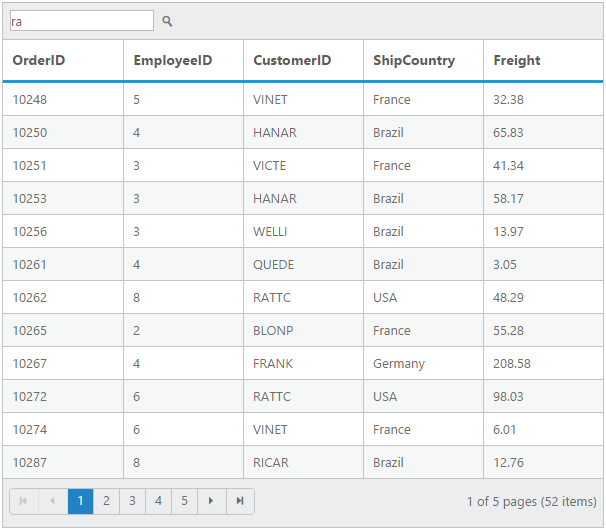Searching
15 Feb 201814 minutes to read
The grid has an option to search its content using the JavaScript method search with search key as parameter. Also, it provides an option to integrate Search text box in grid toolbar, by adding search toolbar item in ToolbarItems property of ToolbarSettings.
The following code example describes the above behavior.
<ej:Grid ID="OrdersGrid" runat="server" AllowSearching="true" AllowPaging="true">
<ToolbarSettings ShowToolbar="true" ToolbarItems="search"/>
<Columns>
<ej:Column Field="OrderID"/>
<ej:Column Field="EmployeeID"/>
<ej:Column Field="CustomerID"/>
<ej:Column Field="ShipCountry"/>
<ej:Column Field="Freight"/>
</Columns>
</ej:Grid>namespace WebSampleBrowser.Grid
{
public partial class Searching : Page
{
List<Orders> order = new List<Orders>();
protected void Page_Load(object sender, EventArgs e)
{
BindDataSource();
}
private void BindDataSource()
{
int orderId = 10000;
int empId = 0;
for (int i = 0; i < 9; i++)
{
order.Add(new Orders(orderId + 1, empId + 1, "VINET", "France", 32.38));
order.Add(new Orders(orderId + 2, empId + 2, "BLONP", "France", 11.61));
order.Add(new Orders(orderId + 3, empId + 3, "VICTE", "France", 45.34));
order.Add(new Orders(orderId + 4, empId + 4, "QUEDE", "Brazil", 37.28));
order.Add(new Orders(orderId + 5, empId + 5, "VINET", "France", 67.00));
order.Add(new Orders(orderId + 6, empId + 6, "RATTC", "USA", 23.32));
orderId += 6;
empId += 6;
}
this.OrdersGrid.DataSource = order;
this.OrdersGrid.DataBind();
}
[Serializable]
public class Orders
{
public Orders()
{
}
public Orders(int OrderId, int empId, string CustomerId, string shipCountry, double freight)
{
this.OrderID = OrderId;
this.EmployeeID = empId;
this.CustomerID = CustomerId;
this.ShipCountry = shipCountry;
this.Freight = freight;
}
public int OrderID{ get; set; }
public int EmployeeID{ get; set; }
public string CustomerID{ get; set; }
public string ShipCountry{ get; set; }
public double Freight{ get; set; }
}
}
}The following output is displayed as a result of the above code example.

Initial Searching
While initializing the grid, there is an option to display only the searched data in grid. To perform initial searching, define Fields, Operator, Key and IgnoreCase in SearchSettings property.
NOTE
Keyvalue must be passed asstring.
The following code example describes the above behavior.
<ej:Grid ID="OrdersGrid" runat="server" AllowSearching="true" AllowPaging="true">
<ToolbarSettings ShowToolbar="true" ToolbarItems="search"/>
<SearchSettings Fields="CustomerID" Operator="Contains" Key="ra" IgnoreCase="false" />
<Columns>
<ej:Column Field="OrderID"/>
<ej:Column Field="EmployeeID"/>
<ej:Column Field="CustomerID"/>
<ej:Column Field="ShipCountry"/>
<ej:Column Field="Freight"/>
</Columns>
</ej:Grid>using System;
using System.Collections.Generic;
using System.Linq;
using System.Web.UI;
using System.Web.UI.WebControls;
namespace WebSampleBrowser.Grid
{
public partial class Searching : Page
{
List<Orders> order = new List<Orders>();
protected void Page_Load(object sender, EventArgs e)
{
BindDataSource();
}
private void BindDataSource()
{
int orderId = 10000;
int empId = 0;
for (int i = 0; i < 9; i++)
{
order.Add(new Orders(orderId + 1, empId + 1, "VINET", "France", 32.38));
order.Add(new Orders(orderId + 2, empId + 2, "BLONP", "France", 11.61));
order.Add(new Orders(orderId + 3, empId + 3, "VICTE", "France", 45.34));
order.Add(new Orders(orderId + 4, empId + 4, "QUEDE", "Brazil", 37.28));
order.Add(new Orders(orderId + 5, empId + 5, "VINET", "France", 67.00));
order.Add(new Orders(orderId + 6, empId + 6, "RATTC", "USA", 23.32));
orderId += 6;
empId += 6;
}
this.OrdersGrid.DataSource = order;
this.OrdersGrid.DataBind();
}
[Serializable]
public class Orders
{
public Orders()
{
}
public Orders(int OrderId, int empId, string CustomerId, string shipCountry, double freight)
{
this.OrderID = OrderId;
this.EmployeeID = empId;
this.CustomerID = CustomerId;
this.ShipCountry = shipCountry;
this.Freight = freight;
}
public int OrderID{ get; set; }
public int EmployeeID{ get; set; }
public string CustomerID{ get; set; }
public string ShipCountry{ get; set; }
public double Freight{ get; set; }
}
}
}The following output is displayed as a result of the above code example.

List of supported operators in searching.
| Operator.Equal |
| Operator.NotEqual |
| Operator.StartsWith |
| Operator.EndsWith |
| Operator.Contains |